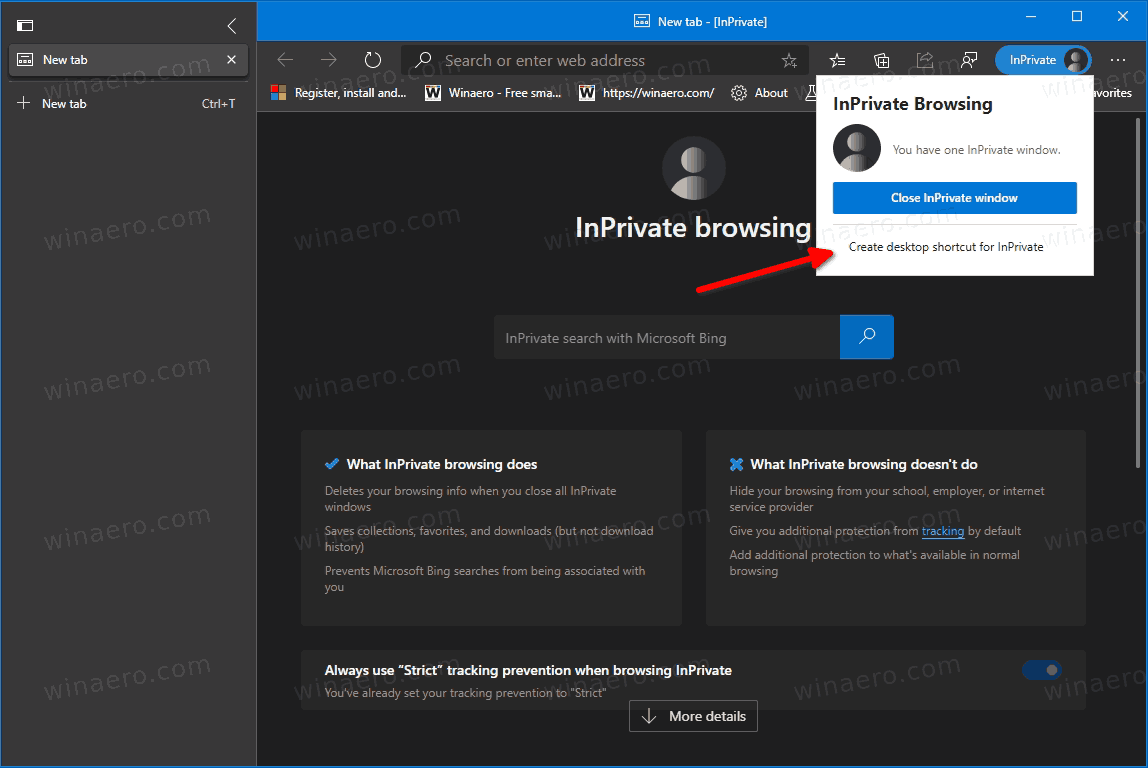Browse InPrivate in Microsoft Edge When you use InPrivate tabs or windows, your browsing data (like your history, temporary internet files, and cookies) isn't saved on your PC once you're done. In Microsoft Edge, select the Settings and More icon, and then New InPrivate window. The new Microsoft Edge will delete your browsing history, cookies, and site data, as well as passwords, addresses, and form data when you close all InPrivate windows. You can open an InPrivate window in different ways: Right-click the Microsoft Edge logo in the taskbar and select New InPrivate window. InPrivate browsing is a private browsing mode in which no browsing history, download history, cookies and site data, and form fill data are remembered. Microsoft Edge saves downloaded files as well as any new favorites created while browsing InPrivate. On Windows 10, Microsoft Edge (like in most browsers) caches online data, such as history, cookies, and internet files to speed up the experience and other purposes. However, because this data can. Microsoft Chromium Edge, like other browsers, includes an InPrivate browsing mode. Private mode is a useful feature of Microsoft Chromium Edge that allows you to surf without leaving traces (like your history, temporary internet files, and cookies) of your activities on your PC. This deletes your browsing info when you close the browser.

InPrivate browsing in Edge is similar to Chrome’s Incognito mode. InPrivate browsing or tabs is a useful feature when you don’t want Edge to store your browsing history, site data or cookies and to block trackers.
However, this feature can be misused when you share your PC with minors or kids. They can use it to hide their online activity. If you don’t want private browsing in Microsoft Edge then you can use the steps described below to block access to InPrivate mode in Edge.
RECOMMENDED: Disable access to Incognito mode in Google Chrome
Step 1
Close all the instances of the Edge browser before proceeding with these steps.
Go to the taskbar search box and search for the Registry Editor app. Right Click on the app in the search results and click on Run as Administrator.
Step 2
In the Registry Editor navigate to the following path:
Right Click on Microsoft Folder and in the context menu, select New > Key.
Name this new key Edge.

This will create an Edge Folder under the main Microsoft Folder. With the Edge folder selected, the address bar in registry editor should show the following path

Step 3
Now Right click anywhere in the empty space on the right side. Select, New > DWORD (32-bit) Value. (Make sure that you are selecting, DWORD (32-bit) Value even if you are running Edge on a 64-bit PC.)
Rename this New key to InPrivateModeAvailability
Step 4
Double click this InPrivateModeAvailability key you just created and set its value to 1, if it is set to 0 or any other value. This setting has to be set to 1 for InPrivate browsing to be disabled in Edge.
Click on OK and close the registry editor and restart your PC.
This should disable the New InPrivate window option in Microsoft Edge’s menu.
Re Enable InPrivate Browsing
If you want to re-enable the InPrivate window then go back to the Registry key, InPrivateModeAvailability, we created in the steps above and set its value to 0. This would bring back the InPrivate window in Edge.
RECOMMENDED:Block a Program from Accessing the Internet in Windows 10
RECOMMENDED: Read aloud Webpages in Android using Google Assistant
Edge Inprivate Browsing Shortcut
Recommended
